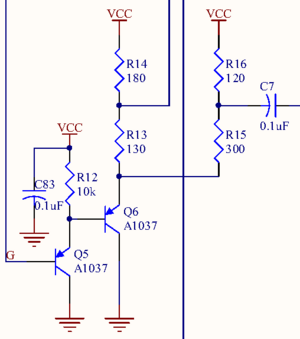We've just updated MediaWiki and its underlying software. If anything doesn't look or work quite right, please mention it to us. --RanAS
Darlington triad: Difference between revisions
From SnesLab
(created page) |
(make it clearer when talking about the base/emitter of the entire Darlington pair) |
||
| Line 7: | Line 7: | ||
[[File:green darlington pair.png|thumb|The Darlington pair itself and some surrounding components for the green color channel, in region B4 of the jwdonal schematic]] | [[File:green darlington pair.png|thumb|The Darlington pair itself and some surrounding components for the green color channel, in region B4 of the jwdonal schematic]] | ||
The bases are connected directly to S-PPU2 (pins 95, 96, and 97) and the emitters' signals are sent to the video encoder (pins 20, 21, and 22). The collectors are grounded. Curiously, the green channel is unique in that Q5 and R12 are in parallel with the polarized C83, but there is no corresponding capacitor for the blue and red Darlington pairs. | The Darlington bases are connected directly to S-PPU2 (pins 95, 96, and 97) and the Darlington emitters' signals are sent to the video encoder (pins 20, 21, and 22). The collectors are grounded. Curiously, the green channel is unique in that Q5 and R12 are in parallel with the polarized C83, but there is no corresponding capacitor for the blue and red Darlington pairs. | ||
Revision as of 19:26, 25 April 2023
The Darlington triad is an array of three PNP Darlington pairs in the jwdonal schematic, one for each of the three color channels. The pairs are:
- Q3 and Q4 for red
- Q5 and Q6 for green
- Q7 and Q8 for blue
The Darlington bases are connected directly to S-PPU2 (pins 95, 96, and 97) and the Darlington emitters' signals are sent to the video encoder (pins 20, 21, and 22). The collectors are grounded. Curiously, the green channel is unique in that Q5 and R12 are in parallel with the polarized C83, but there is no corresponding capacitor for the blue and red Darlington pairs.

